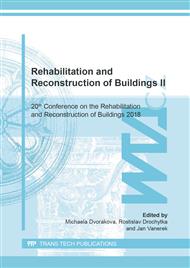p.88
p.93
p.103
p.109
p.115
p.123
p.129
p.136
p.145
Viscoelastic Properties of PVB Interlayer for Laminated Glass Structures Used in Building Reconstructions
Abstract:
Laminated glass is a structural element used extensively in a reconstruction of existing building structures because of its transparency and simplicity. When using laminated glass as a glass staircase, balustrades, transparent flooring, facades or other structural elements, it is advisable to consider the shear interaction of individual glass panes in the cross-section. A conservative approach where the glass panes shear interaction is not considered, is uneconomical. This interaction depends on the properties of polymeric interlayers used in lamination process. Various commercial products based on PVB (polyvinyl butyral), EVA (ethylene vinyl acetate), ionomer, or thermoplastic polyurethane (TPU) are used. Stiffness of polymers depends on temperature and duration of a load. Interlayers exhibit the viscoelastic properties and temperature dependency usually described by the generalized Maxwell model and WLF model (Williams-Landel-Ferry). Parameters of these models are the most effectively determined by Dynamic Mechanical Thermal Analysis (DMTA), where the material is cyclically loaded at different frequencies and temperatures. Material parameters were found by DMTA in shear for PVB type of interlayer Trosifol® BG R20. In addition, the experimental quasi-static loading tests in shear were performed at different loading rates and at various temperatures. These experimental stress-strain diagrams were compared to the theoretical stress-strain relations obtained from Maxwell model with material parameters based on DMTA testing. All tests were performed in Klokner Institute CTU in Prague.
Info:
Periodical:
Pages:
115-122
Citation:
Online since:
June 2019
Authors:
Price:
Сopyright:
© 2019 Trans Tech Publications Ltd. All Rights Reserved
Share:
Citation:


